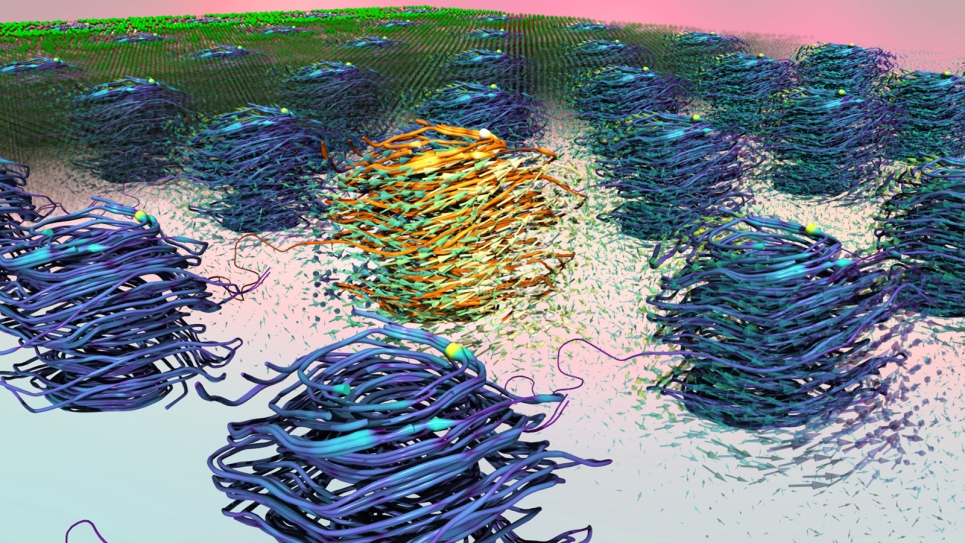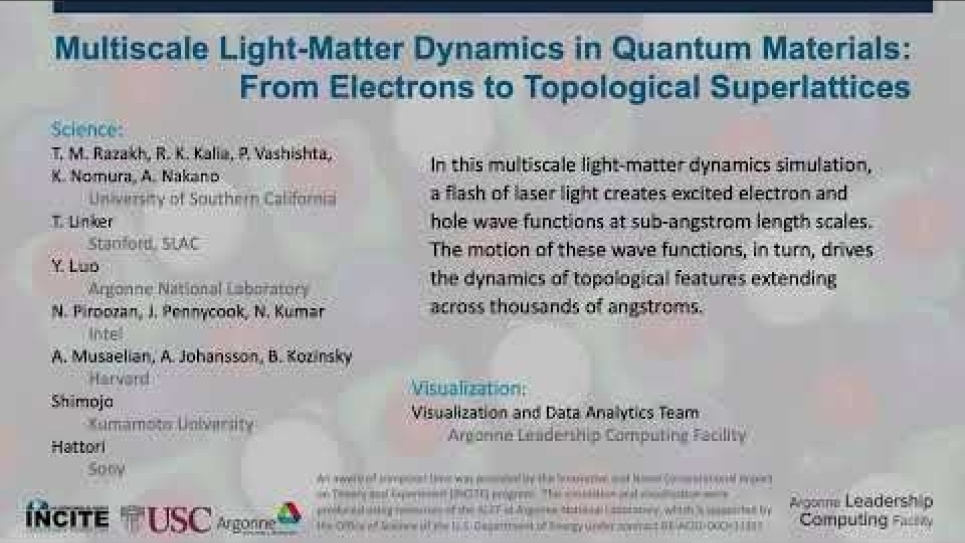
Photo-switching of a ferroelectric nanoscale structure in lead titanate. (Image: ALCF Visualization and Data Analytics Team)
Using ALCF's Aurora supercomputer, researchers from USC performed simulations of light-matter interactions in quantum materials at an unprecedented scale and level of detail. The team’s work is a finalist for the prestigious Gordon Bell Prize.
Researchers using the Aurora supercomputer at the U.S. Department of Energy’s Argonne National Laboratory have achieved the largest-ever simulations of light interacting with quantum materials. Their groundbreaking work could help drive the discovery of new materials for high-speed, low-power electronics and computing technologies.
“Light-matter interactions in quantum materials hold great promise for meeting the growing energy demands of AI and next-generation computing,” said Aiichiro Nakano, professor of computer science at the University of Southern California (USC). “These materials behave in ways that are difficult to observe directly, so we rely on large-scale simulations to understand how light alters their properties at the atomic level.”
Aurora, one of the largest and most powerful computers in the world, allowed the USC-led team to simulate light-matter dynamics at a massive scale with the aid of AI. They were able to perform simulations of materials with more than one trillion atoms. Their runs on Aurora achieved speedups thousands of times faster than earlier methods and reached a sustained performance of 1.87 exaflops. One exaflops equals one quintillion, or a billion billion, calculations per second. Aurora, one of the first exascale systems, is operated by the Argonne Leadership Computing Facility (ALCF), a DOE Office of Science user facility.
The team’s work has been named a finalist for the Association of Computing Machinery’s Gordon Bell Prize, one of the top honors in high-performance computing.
The milestone marks both a scientific and computational breakthrough. It’s the first time that light-matter interactions in quantum materials have been modeled at this scale and level of detail. The effort also demonstrates how physics-based simulations can evolve alongside AI workloads to drive advances in speed, scale, and accuracy.
“With the emergence of exascale systems powered by GPUs (graphics processing units), many believed simulation-based science was facing an existential crisis,” Nakano said. “The latest GPUs excel at low-precision AI computations, but they are not designed for the high precision required by traditional physics models. With Aurora, we were able to test a new approach that uses the hardware efficiently for physics simulations that in turn are enhanced with AI.”

Shining a light on quantum materials
Quantum materials display unusual behaviors that arise from the laws of quantum mechanics. The movement of electrons can produce properties like superconductivity and magnetism, which could transform future computing, energy storage, and sensing technologies. Light can also influence how these materials behave, giving researchers a way to control or enhance their properties.
Capturing how light interacts with quantum materials in a single simulation, however, is a huge challenge.
“We have a very complex problem we call multiscale simulation,” Nakano said. “That means going from the very small, atomic level to the very large, like the device level. It covers both space and time, and involves many different kinds of physics all working together.”
To tackle this problem, the USC team created the Multiscale Light-Matter Dynamics (MLMD) software framework. It combines methods to model how light interacts with matter and uses AI to track the movement of atoms. Together, these tools connect small-scale atomic motion to larger material structures.
“To carry out these simulations, our software uses a unique divide-conquer-recombine approach,” Nakano said. “This allows us to chop up the scientific problem into smaller pieces, decide which parts run best on different parts of GPUs and which on CPUs, and then bring the results together to form a full picture.”
To extend the simulations further, the USC team collaborated with Harvard researchers to integrate an AI foundation model named Allegro-FM. The model learns from a wide range of materials and predicts atomic behavior, making it possible to run large-scale simulations more quickly.
“Allegro-FM allows us to simulate atomic interactions across nearly the entire periodic table,” said Ken-ichi Nomura, associate professor of materials science and chemical engineering at USC. “It gives us quantum-level accuracy while scaling up to systems of more than a trillion atoms.”
A quantum leap in simulation
Aurora is an Intel-HPE machine with 10,624 nodes and 63,744 GPUs, making it one of the largest and most powerful systems ever built.
Working closely with experts from the ALCF and Intel, the researchers prepared software for Aurora’s unique architecture. They resolved scaling challenges and ensured the system could handle the large workloads efficiently. As part of that effort, USC graduate student Taufeq Mohammed Razakh gained hands-on experience with Aurora during an ALCF hackathon and through a summer internship working with Ye Luo, Argonne computational scientist and a co-author of the team’s study.
“For a PhD student, it’s been really rewarding to be part of the team at USC working on exaflop simulations of quantum materials,” said Razakh, first author of the team’s paper. “There was a learning curve in preparing our applications for Aurora’s GPUs, but spending my summers at Argonne with my mentor Dr. Luo, along with collaboration with Argonne and Intel staff, made it possible.”
Running on the full Aurora system, their framework delivered up to 3,780x faster time-to-solution than previous methods.
The team’s simulations aim to uncover how light can trigger structural changes in ferroelectric topological materials. These compounds can switch their internal electric structure and conduct electricity in unusually stable ways. Their combined properties make them promising candidates for future low-power, high-speed devices. The team’s largest simulations focused on lead titanate (PbTiO₃), modeling a system of up to 1.2 trillion atoms.
“By simulating how light can switch ferroelectric topological materials, we’re opening the path to petahertz electronics, which are millions of times faster than today’s transistors and far more energy efficient,” Nakano said. “These materials could form the foundation for ultrafast, low-power devices we call topotronics.”
The team’s success on Aurora shows how quantum physics, supercomputing, and AI are converging to solve some of the most complex problems in science.
“Our work makes it clear that simulation remains a critical part of scientific computing,” Nakano said. “For the first time, we’ve been able to perform simulations of light, electrons, and atoms at exascale, providing insights to advance the design of new materials, devices, and experiments.”
The team’s study, “Multiscale light-matter dynamics in quantum materials: from electrons to topological superlattices,” was authored by Taufeq Mohammed Razakh, Rajiv Kalia, Priya Vashishta, Ken-ichi Nomura, and Aiichiro Nakano from USC; Thomas Linker from DOE’s SLAC National Accelerator Laboratory; Ye Luo from Argonne; Nariman Piroozan, John Pennycook, and Nalini Kumar from Intel; Albert Musaelian, Anders Johansson and Boris Kozinsky from Harvard; Fuyuki Shimojo from Kumamoto University; and Shinnosuke Hattori from Sony Group Corporation.
Access to ALCF computing resources was awarded through DOE’s Innovative and Novel Computational Impact on Theory and Experiment (INCITE) program and ALCF’s Early Science Program.